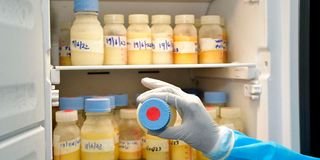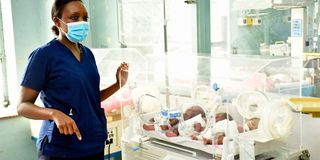How breast milk donors are saving lives of preterm babies
What you need to know:
- Since the first-ever milk bank in the country was set up in October 2019, Pumwani has managed to save 931 infants born too soon.
- The World Health Organization has issued a global call to scale up the establishment of human milk banks for the provision of safe donated human milk for babies who have no access to their mother’s own milk.
7.53am.
As we make our way to the newborn unit at Pumwani Maternity Hospital in Nairobi, the hallway is filled with shrieking sounds of infants crying relentlessly.
A team of about 15 nurses is already at work. They are changing diapers and feeding preterm infants (babies born too soon before 37 weeks of pregnancy are completed).
We meet Lilian Nthenya, 31, who for the last one week has been staying at the hospital after delivering a set of preterm twins currently placed in an incubator and labelled ‘Lilian Twin 1’ and ‘Lilian Twin 2’.

Lilian Nthenya during the interview at Pumwani. Donated breast milk helped her nurse her newborn twins.
“Last week I went into labour and gave birth to premature male twins weighing 1,190 and 1,590 grammes. Doctors then learned that I was not able to produce enough milk to feed them and this is why they introduced me to donated human milk (DHM), which they explained is a safe alternative in the absence of mother’s own milk (MOM) and has immense advantages,” she tells Healthy Nation.
MOM is the optimal feed for all newborn babies, especially the sickest and most vulnerable. The World Health Organization (WHO) recommends donated milk as a lifesaving alternative for children with no access to their mother’s own milk.
DHM differs from MOM due to a variety of reasons, many of which relate to the handling and processing of the milk.
For example, nutritional content of DHM varies greatly, with a mean difference in energy intake of 38.7 kcal/kg/day based on full enteral feeds of 180 ml/kg/day. In addition, freezing, storage and heat treatment all impact on milk components and qualities. The method used — holder pasteurisation — (heating milk for 30 min at 62.5 ̊C) can reduce both fatty and amino acid content in DHM.
“My twins are doing well thanks to the lifesaving donated milk Pumwani doctors provided. I explained to their father and he agreed after he learnt that the milk has no side-effects whatsoever,” the first-time mother says as she watches her twins drink the milk away.
In the next room adjacent to Ms Nthenya’s, Ms Winnie Nyambura, 22, is also admitted at the maternity hospital.
“Last week I gave birth to a preterm baby. I am still admitted here because my baby is in the nursery.
“I have decided to donate breast-milk for free because I produce too much. It excessively comes out three or four times a day yet my baby has not started using it. Instead of going to waste, it can perhaps save another infant who has been orphaned at birth or whose mother cannot produce enough milk.”

Bottles of raw breast milk that needs to go through a pasteurisation process before consumption kept in a freezer at Pumwani.
She discloses that before she was allowed to donate to the milk bank at Pumwani, she was fast taken to the laboratory for a series of tests for various diseases, which she consented to.
Faith Njeru, the nurse-in-charge at the human milk bank department, explains to Healthy Nation how they process DHM and ensure that it is safe for consumption as she fits an electrical breast pump onto Nyambura.
Breast pumps consist of a suction cup that fits over each of the nipples, a funnel and a collection bottle. The electronic device mimics the sucking action of a baby to stimulate milk to start flowing then extracts the milk and collects it in a bottle.
“For one to be eligible for donation, we first take them through counselling and fully explain why this is important. We take potential mums through multiple-step screening after they fill up a questionnaire. The screening includes their lifestyle and medical history,” she says while observing that everything needs to be negative, basically a stable mother with no medical conditions.
A number of conditions will prevent a mother from becoming an approved donor. They include use of certain medications, use of herbal supplements or medications to increase milk supply, a positive test for HIV, HTLV (Human T-lymphotropic Virus), hepatitis B or C, syphilis, use of illegal drugs, use of tobacco or marijuana products, e-cigarettes or vaporisers and consumption of more than one serving of alcohol per day and/or five servings per week.

Acting head in-charge of the newborn unit at Pumwani Maternity Hospital, Dr Muthoni Ogola, checks on newborns placed in an incubator at Pumwani Maternity Hospital on June 20, 2023.
In the pasteurisation room where the donated milk is taken after collection, each donation is labelled using codes and the donor’s name is processed independently.
“We do pooling from single donors; we don’t mix milk from different mothers but all the milk that is donated by a single mother is placed in a single pool.
“After pooling we take about 3ml of the donated milk from each sample for what we call pre-pasteurisation testing, which is a culture milk of the test to ensure, verify and confirm that the milk is safe before it is dispensed to the babies after the entire process,” she explains while highlighting that sometimes DHM is just not enough for all the babies as they get five to 10 mothers in a day who are willing to donate milk hence there is need to scale up.
“This year so far we have 95 preterm babies who have benefited. We get requests from other public and private hospitals within Nairobi County to supply them but at the moment we cannot. Perhaps once we scale up and are able to fully meet our own demand, we will then share with them,” the nurse-in-charge assures.
“Before we set up the first-ever milk bank in the country in October 2019, our crude infant mortality rate was on average of 20 per cent but now we are at 7 per cent.
“We also now save up to Sh1.3 million annually that could have otherwise been used to buy baby formula,” says Dr Muthoni Ogola, the acting head in-charge of the newborn unit at Pumwani.
She notes that since inception, Pumwani has managed to save 931 preterm babies, thanks to the human milk bank.
“At least 15 babies are born here every day, which translates to at least 450 newborns per month,” she adds as we enter a special neatly arranged room equipped with breast pumps. Ten lactating mothers are waiting to pump breast milk — but not for their own newborns.
According to the African Population Health Research Centre(APHRC), Kenya has made substantial progress in child survival over the past decade.
“However, a neonatal death rate of 22 deaths per 1,000 live births, an estimated 40,000 annual deaths in the first month of life mainly due to high prematurity rate (12.3 per cent) and low birth weight rate (8 per cent) is reported,”APHRC explains. It indicates that the country runs the risk of not achieving the Every Newborn Action Plan’s goal of a neonatal mortality rate below 10 deaths per 1,000 live births by 2035, signifying the urgent need to focus on a healthy start to life.
“Human milk has the greatest impact on child survival. Optimal breastfeeding alone has the potential to avert an estimated 820,000 child deaths globally and improve child morbidity.”
This is why WHO has issued a global call to scale up the establishment of human milk banks (HMBs) for the provision of safe donated human milk for babies who have no access to their mother’s own milk.
Kenya is the third sub-Saharan Africa country with a milk bank. The others are South Africa (set up in 1980) and Cape Verde in 2011.
It is interesting to note that the first hospital in the world to formally freeze and distribute donor milk launched in Vienna in 1909 has not yet implemented the global best practice of providing donated human milk from human milk banks.
Recognising the urgent need to increase access to human milk, Kenyan policymakers have sought support to document the feasibility of establishing human milk banks and to rapidly develop local HMB guidelines in the country, according to APHRC.
“Therefore, PATH and APHRC are supporting the Health ministry and other Kenyan stakeholders to tailor the Mother-Baby Friendly Initiative Plus (MBFI+) model, which is an integrated hub for infant nutrition and survival—to the Kenyan context,” APHRC explains while further disclosing that this is based on a formative assessment in Nairobi County involving 71 participants between August and December 2016, to assess the feasibility and acceptability of human milk banking.
“Although breast milk donation and milk banking was a new idea to most (74 per cent) of the women interviewed, a majority of them were positive about the concept. While about 90 per cent were generally positive about the concept, about 80 per cent indicated they would donate their breast milk to an HMB and about 60 per cent indicated they would allow their children to be fed with donated human milk,” the findings showed.
In May this year, the “Born too soon: decade of action on preterm birth", a report issued jointly by WHO and the United Nations Children’s Fund in collaboration with PMNCH, the world’s largest coalition for women, children, and adolescents, found that 13.4 million infants globally were born prematurely in 2020 and close to one million of these succumbed to early birth complications.
This means that nearly one in 10 babies are born before the 37th week of gestation.
“In every two seconds, a baby is born too soon globally and in every 40 seconds, one of those babies dies,” the report found.
The findings highlighted that Kenya is among the countries that have recorded moderately high preterm births (below 10 per cent) with the total number of preterm babies that were born in the country in 2020 being placed at 127,500 out of 1,455,900 children that were born that year.
The global health authority and her partners further disclosed that there was a stagnant preterm birth rate across all global regions in the last decade and this resulted to 152 million babies born prematurely from 2010 to 2020.
Speaking then at the official launch of the report, Prof Joy Lawn, co-lead author of the report from the London School of Hygiene & Tropical Medicine, pointed out that the cost of inaction over the last decade was 152 million babies born too soon.
“Greater investment in the care of vulnerable newborns can save millions of families from heartbreak," he said.
But what causes preterm births ?
According to experts at Aga Khan University Hospital(AKUH),in many cases the cause of preterm birth remains unknown though a number of factors including socio demographic ( such as age less than 25 and more than 35, socio-economic factors such as household strain, income, educational levels), nutritional (lack of micronutrients) biological ( genetics, infections, non-communicable diseases, obesity, substance abuse) environmental factors ( environmental toxins, household pollution, smoking) and maternal stressors (stress, psychological distress, depression, anxiety) are under investigation.
“In about one third of the preterm births, the decision for an early delivery had to be taken by the medical team due to the mothers' and/or baby's condition (such as a mother with high blood pressure or diabetes or other medical condition necessitating early delivery of baby, for example twin pregnancy).”
On whether these causes can be identified early and managed, AKUH responds,
“Yes and no.”
“Yes in the sense that prevention of a preterm birth is possible, to some extent. Good health before going into pregnancy is encouraged.”
“This is called pre-conception care. Balanced diet with micronutrient supplementation, screening for infections including sexually transmitted infections, avoiding harmful substances such as smoking and alcohol intake, mental well-being, social support, weight management, birth spacing at least more than 24 months, review of any long term illness or medications are all necessary before a woman gets pregnant,” AKUH observes.
In an interview with Healthy Nation, Dr Emily Njuguna, a paediatrician and the Africa Technical Advisor at PATH, disclosed that in Kenya, newborn mortality has not decreased as expected in recent years.
“According to the Kenya Demographic Health Survey (KDHS), we have reduced the number of deaths from 22 deaths per 1,000 live births in 2014 to 21 deaths per 1,000 live births in 2022.
“Small and sick babies account for a significant proportion of newborn deaths in the country annually and must be a priority group to reduce newborn mortality rates and reach the SDG target of 12 deaths per 1,000 live births.”
The technical director adds that nutrition is critical to newborn survival, particularly for small and sick newborns.
“One of the most crucial strategies for safeguarding newborn lives is providing an exclusive human milk diet that has all the nutrients they require to survive, grow and thrive.
“However, in Kenya our rates of early initiation of breastfeeding within one hour and exclusive breastfeeding rates have reduced to 60 per cent in the KDHS of 2022.”
She is of the view that wet nursing, an ancient practice in which a lactating mother would breastfeed another woman's baby in the event of infant abandonment, maternal death or immediately following childbirth when the mother's milk has not yet fully come, happened because women understood the importance of providing breast milk to children.
“Today, informal milk sharing and wet nursing are becoming increasingly prevalent because formula costs are prohibitive to most women. This practice is happening despite risks of disease transmission such as HIV and Hepatitis, as well as exposure to medicines, alcohol, illegal drugs or other harmful contaminants,” she says.
“To prevent the transmission of infections, we must establish systems to formalise milk-sharing services through accredited human milk banks that screen donors for transmissible diseases and pasteurise the donor human milk to make it safe for consumption,” the paediatrician highlights while urging the national and county governments to prioritise doing so.
Dr Njuguna believes that Kenya is uniquely positioned to scale up human milk banking because of the successful pilot project at Pumwani Maternity Hospital that demonstrated feasibility. “However, we need investments, regulations and policies to scale up this intervention to newborns most at risk of death nationwide.”
At the gate on our way out, Mr John Makatiani, a boda boda rider who is dropping off a client and hails from Dandora, is grateful that the human milk bank at Pumwani exists.
“Two years ago I brought my expectant wife to Pumwani and after she gave birth, doctors told us that she could not produce enough milk to breastfeed our son due to medical complications. They gave the baby donated breast milk they had stored in bottles. Those tiny 10 ml bottles are pure gold, they saved my boy.”





